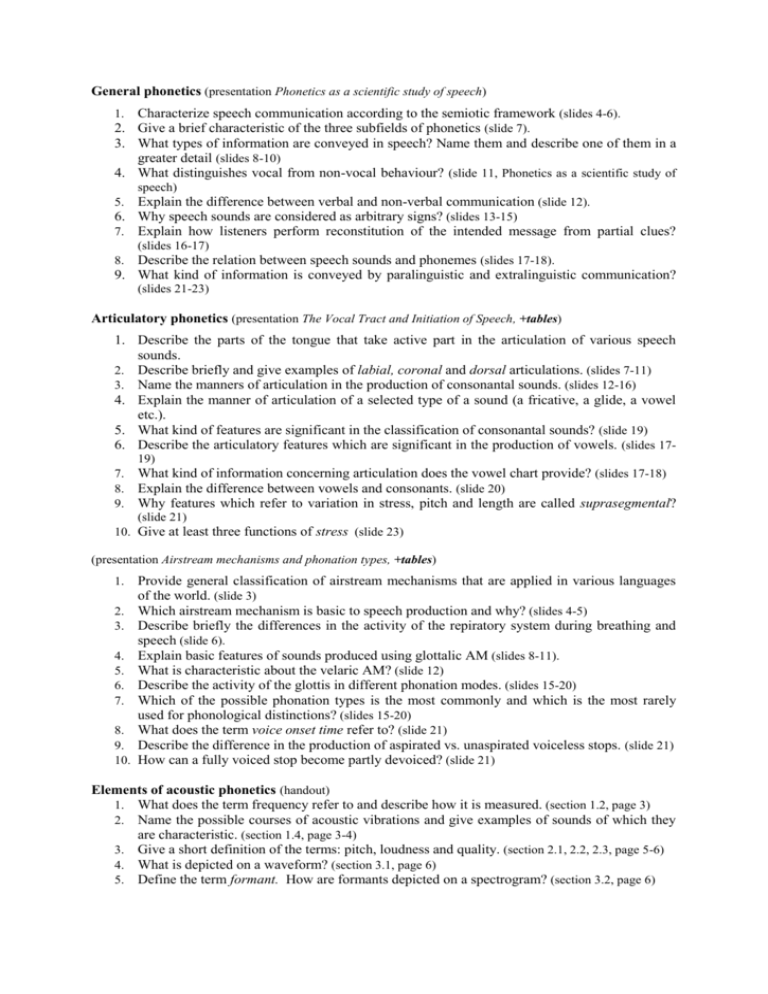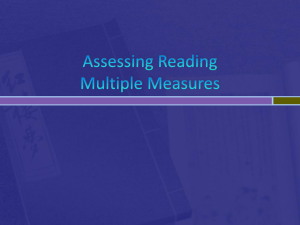General phonetics (presentation Phonetics as a scientific study of
advertisement

General phonetics (presentation Phonetics as a scientific study of speech) Characterize speech communication according to the semiotic framework (slides 4-6). 2. Give a brief characteristic of the three subfields of phonetics (slide 7). 3. What types of information are conveyed in speech? Name them and describe one of them in a greater detail (slides 8-10) 4. What distinguishes vocal from non-vocal behaviour? (slide 11, Phonetics as a scientific study of 1. speech) Explain the difference between verbal and non-verbal communication (slide 12). 6. Why speech sounds are considered as arbitrary signs? (slides 13-15) 7. Explain how listeners perform reconstitution of the intended message from partial clues? 5. (slides 16-17) Describe the relation between speech sounds and phonemes (slides 17-18). 9. What kind of information is conveyed by paralinguistic and extralinguistic communication? 8. (slides 21-23) Articulatory phonetics (presentation The Vocal Tract and Initiation of Speech, +tables) 1. Describe the parts of the tongue that take active part in the articulation of various speech sounds. 2. Describe briefly and give examples of labial, coronal and dorsal articulations. (slides 7-11) 3. Name the manners of articulation in the production of consonantal sounds. (slides 12-16) 4. Explain the manner of articulation of a selected type of a sound (a fricative, a glide, a vowel etc.). 5. What kind of features are significant in the classification of consonantal sounds? (slide 19) 6. Describe the articulatory features which are significant in the production of vowels. (slides 1719) 7. 8. 9. What kind of information concerning articulation does the vowel chart provide? (slides 17-18) Explain the difference between vowels and consonants. (slide 20) Why features which refer to variation in stress, pitch and length are called suprasegmental? (slide 21) 10. Give at least three functions of stress (slide 23) (presentation Airstream mechanisms and phonation types, +tables) 1. 2. 3. 4. 5. 6. 7. 8. 9. 10. Provide general classification of airstream mechanisms that are applied in various languages of the world. (slide 3) Which airstream mechanism is basic to speech production and why? (slides 4-5) Describe briefly the differences in the activity of the repiratory system during breathing and speech (slide 6). Explain basic features of sounds produced using glottalic AM (slides 8-11). What is characteristic about the velaric AM? (slide 12) Describe the activity of the glottis in different phonation modes. (slides 15-20) Which of the possible phonation types is the most commonly and which is the most rarely used for phonological distinctions? (slides 15-20) What does the term voice onset time refer to? (slide 21) Describe the difference in the production of aspirated vs. unaspirated voiceless stops. (slide 21) How can a fully voiced stop become partly devoiced? (slide 21) Elements of acoustic phonetics (handout) 1. What does the term frequency refer to and describe how it is measured. (section 1.2, page 3) 2. Name the possible courses of acoustic vibrations and give examples of sounds of which they are characteristic. (section 1.4, page 3-4) 3. Give a short definition of the terms: pitch, loudness and quality. (section 2.1, 2.2, 2.3, page 5-6) 4. What is depicted on a waveform? (section 3.1, page 6) 5. Define the term formant. How are formants depicted on a spectrogram? (section 3.2, page 6) Describe the relation between the changes in the frequency of the first and second formant and vowel quality. (section 3.3.1, page 7) 7. How can oral stops, fricatives and glides be identified on the spectrogram? (section 3.4.1, page 6. 8; sec. 3.4.5 p.12-13, sec. 3.4.6 p. 13-15) 8. 9. Describe the effect of nasality on the acoustic structure of a sound. (section 3.4.2, page 9) Describe the acoustic features of sounds that provide information on their place of articulation. (sec. 3.4, p. 8) 10. Explain the relation between the place of articulation and frequency of the fricative noise in the production of fricatives. (sec. 3.4.6, p.13-14) Vowels in general and Polish vowels (handout) 1. 2. 3. 4. 5. 6. 7. 8. 9. 10. Classify vowels with respect to tongue position. (sec. 1, figure 1) Explain the terms cardinal vowels and secondary cardinal vowels (sec. 1 and 1.1) Describe the relation between the number of vowels and the number of consonants in a language (sec. 3.2) How the tendency to form patterns affects the choice of vowels in a language? (sec. 3.2) Describe the relation between vowel backness and lip rounding (sec. 4.1, p. 5-6) Explain the difference between nasal and nasalized vowels (4.2.1, p.6-7) Describe the chart of Polish vowels (classify sec. 5.1.1, p. 9-10) Classify Polish vowels according to lip rounding (sec. 5.4, p.12) How are Polish nasal vowels realized? (sec. 4.2.2 p.8) Describe the phonetic mapping of the graphemes [ą] and [ę] (sec. 7, p.16) Polish consonants (handout) 1. Describe the stages in the articulation of stops. (sec. 2.1, p.2) 2. Give the general articulatory characteristic of palatalization and describe context in which it occurs. 3. Describe briefly the articulation of fricatives and classify them according to the place of articulation. (sec. 4.1, p.6) 4. Explain the difference in the articulation of sequences of a plosive+fricative and affricates. (sec. 5.1, p.12) Explain the difference in the articulation of nasal and oral stops, and classify Polish nasal stops according to the place of articulation. (sec. 6.1, p.15) 6. Describe briefly the articulation of Polish liquids: lateral /l/ and trill /r/. (sec. 7.1 and 7.2, p. 175. 18) In the exam you can also be asked to classify Polish consonants according to place and/or manner of articulation, so please study the tables from the website! (link: Articulatory phonetics: Vowels and consonants) Assimilation (handout) 1. Explain the difference between progressive and regressive assimilation and give examples. (sec. 1.2) 2. Give examples of a progressive voicing and devoicing that occur within word boundaries (intra-word assimilation, sec. 2.2.1, 2.2.2) 3. 4. What kind of a process occurs at word boundaries? (sec. 2.2.3) What does the term affrication refer to? (sec. 5)








